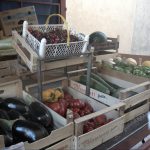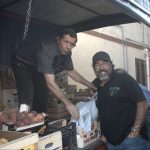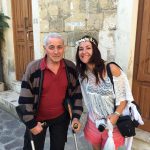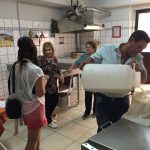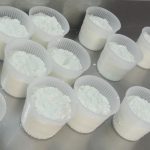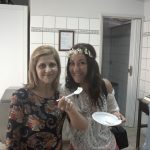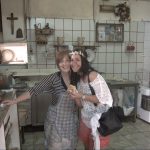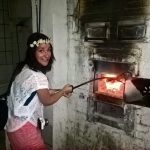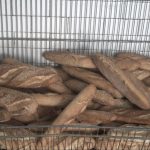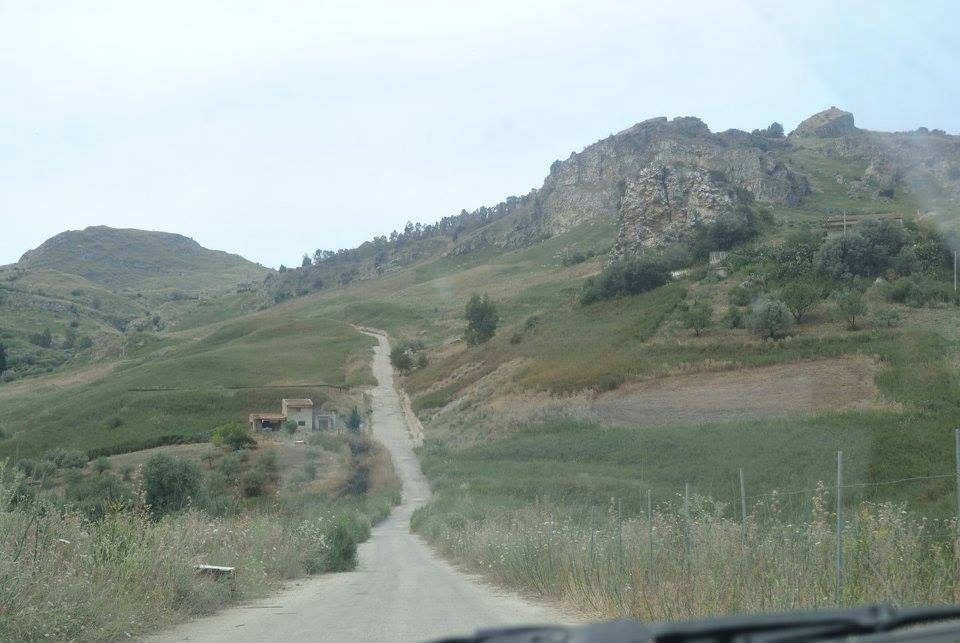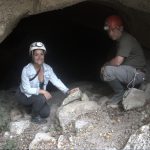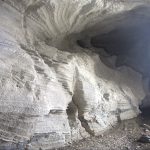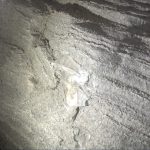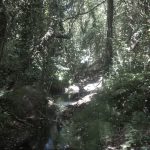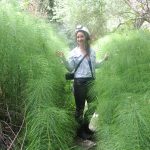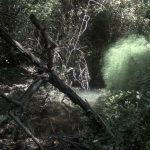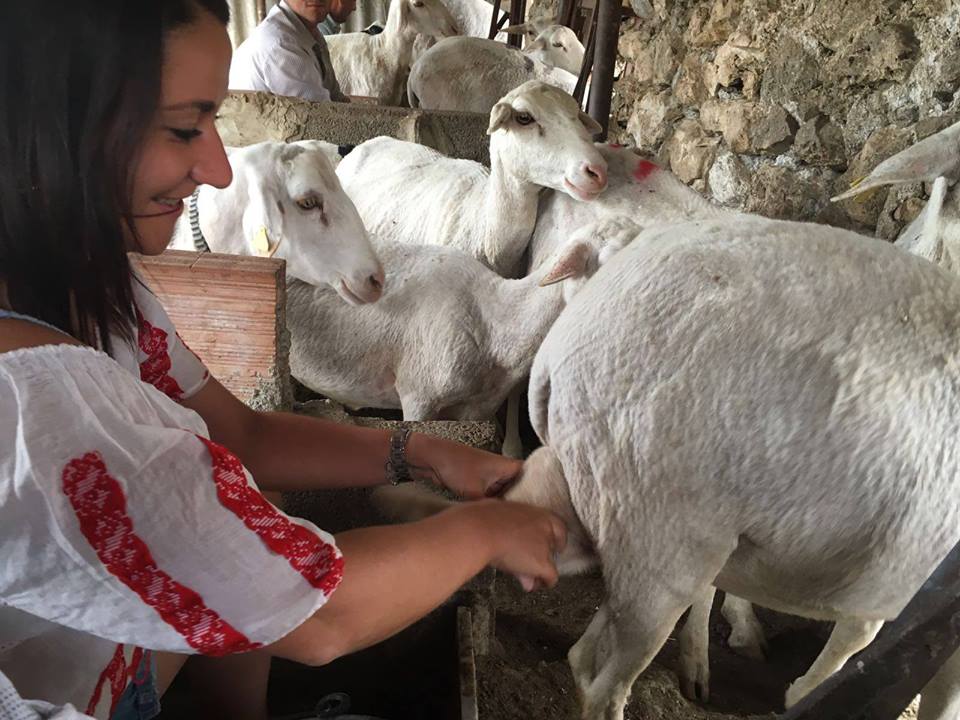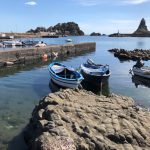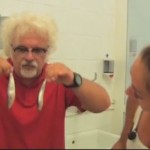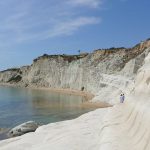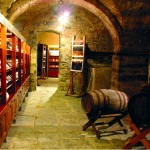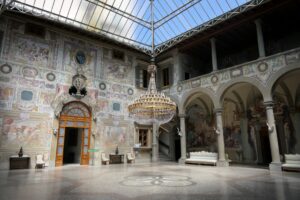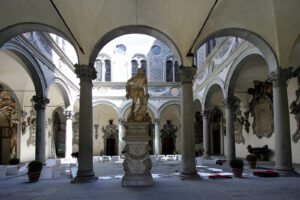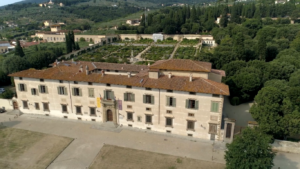A village near Catania where takes place a masterpiece of Italian literature
Discover Sicily: get a taste of this land and its traditions
Ricotta cheese making, home made bread and milking time!
by Roxana Iacoban
Italia Slow Tour Ambassador across Sicily with Legambiente
Local fruit and veggies vendor, Garco’s ricotta cheese
Pierfilippo met me for breakfast in one of the bars in the main square, where I met other locals. Then I heard this singing like voice that was definitely comunicating a message but I wasn’t sure what its nature was. We got closer, and there he was, the fruit and groceries vendor, who was up since 7 am to provide the locals with fresh and seasonal fruit and vegetables. He was pleased to have met me and he gave me a handful of cherries and a bag of Sicilian figs and then he carried on with his canto.
- Veggies & fruit in Sicily
- Grocery vendor
- Angelo and Roxana
Then while heading towards the local “cheese lab” we met Angelo, a lovely old man who shook my hand and told me about his son, the shepherd who transmitted his profession and the love for his job to his sons. He offered me candy and told me I would always be welcome there. We walked a few steps up the path and there we were, in the dairy lab of the Garco family, where fresh ricotta and cheese is made, and where local people come buy it on the spot, daily. I met Angelo junior who was coming in with fresh milk containers, directly from his 600 sheep, to be transfered into a huge container to keep it cool. Then fresh ricotta was then to be made the day after and with the addition of different ingredients like paprika, black pepper, pistachios, one could personalize it before coming to pick it up. I found that amazing. There was also a cooler for seasoned cheese who looked just appetizing!
- Ricotta lab, Family Garco
- Shepherd’s wife and ricotta tasting
Home made bread at Maria’s Oven
After this lovely encounters we went on to meet Maria, a lady born in England from Sicilian parents who thereafter moved back to Sant’Angelo Muxaro to continue the family bread making tradition, with the same oven, tools and techniques of her great grandma. Maria is used to meeting international people, because due to the traditional recipès and the way she kept the bakery as “once uopon a time” she receives many visits from small groups of foreign people, who are curious to know more about ancient traditions and to build a stronger bond with nature and people populating it. They want to “get their hands dirty” and cook their own bread and pizza, to then share and eat it on a lunch table outside the bakery. Living in the city and in industrialized countries we often loose touch with what is real and with the origins of things.
- Maria bread
- Home making bread in the oven
- The bread
As with the ricotta, the bread is bought by locals on the spot, and they don’t even have to knock; they come in and Maria already knows want they want. She made me a bread sandwhich with you’d say “just” olive oil, origano and salt, all local ingredients, and that, allow me, was sublime!
Afternoon: Sant’Angelo Muxaro “water caves”
A natural reservation in the custody of Legambiente.
I met Marco at the main bar in the square and after stopping off at the Legambiente office, where I had to pick some rubber boots and a helmet, and where Marco gave me some basic information on what we were going to see and the types of rocks we were going to observe, the importance of water and how rivers change their course constantly, making nature consequently change as well, shaping everything by its own desire.
Long, wide fields of golden grain, here and there some greener vegetation, like olive and pistachio trees, and there we were. We parked the car and off we went down the hills, careful not to slip. The yellow colour predominated over the hills and surroundings, so I wasn’t expecting to come across anything different soon. But then, descending we slowly bumped into more humid areas and very different vegetation. As we entered the cave, the water would sometimes get almost to your knees, and there I finally spotted the different types of rocks Marco had told me about.
- Roxana and Marco inside the cave
- Water scultures in rocks
- Glass looking rock
Due to the never ending change in the water course, the gypsum rocks have also changed shape in a some what artistic way. The main course of water comes from the Platani River that runs from the North side of the town. A particular rock caugt my eye due to its sparkle and glass looking aspect. It gave an almost magical feel to the whole setting. This rock was used a lot in construction and house building more exactly because it made the facades look prettier and glowier. This tradition has almost disappeared, but you can still find it in some old construction and it looks simply beautiful!
At the end of the first cave, as we went deepeer in this oasis, we came across a rich vegetation and variety of insects: dragon flies, bees, all sorts of wasps, butterflies, water insects and even grass snakes. I felt like Alice in wonderland, exploring an unexpected dreamland. We stopped for a moment to enjoy the silence of the underground oasis, listening to the insects’ buzz and the water springs flow. We followed the water and climbed up to the second cave. This one had stalactites of differents shapes and forms and Marco explained me that it was due to the wind and the water course, that the rocks took those peculiar shapes, in a random yet fascinating way. It was like admiring a piece of Art, this time not done by a person but by nature itself.
- Oasis nature
- Roxana and ancient plants
- Oasis nature
We then went uphill again and the panoramic view turned back to “normal”. It felt like I had been dreaming, a hidden underground mistery only known by few. I felt happy, rich and dreamy. We headed back to the town, stopping off at the local groceries to pick up some of the last oranges for me to taste. I said goodbye to Marco and then went up to my lovely central apartment where I took a nap and finished off the sandwhich that Maria made me. Just delicious!
Evening: The Garco family and their 600 sheep
After getting back to my senses, Pierfilippo picked me up and we went down to meet the lovely shepherd family named Graco. They were waiting for their 600 sheep to finish feeding to then take them back to the stall, where they would milk them one by one.
I got a chance to talk to the young shepherd’s sons, who just as the father decided to take on that profession and dedicate their life to it. They were about 22 years old and already married and already settled. They seemed a lot more determined and self confident that most of the young men that age one would meet in any city. They worked hard, you could see it from their hands, but there was no sign of hesitation or doubt in their eyes. They were to continue being shepherds and so would their sons and their grandsons to come.
Milking time was around the corner, so I decided to venture myself in this art and give it a try. It all seemed easy. I had milked a cow before. But believe me, it was way more difficult than it seemed. The boys made it seem like a piece of cake, but not until I tried it with my own hands. At sheep nr 3 I was slowly becoming better, and they all complimented me (don’t know if for the effort or the bravery). They finished milking the 600 sheep in 1 h 30. Determination, sweat, perseverence, hard work. I never thought about what it really takes to get milk on our tables.
We said goodbye to the shepherd and we headed off to Agrigento. It was around an hour drive, and I had time to reflect and think about what I had experienced.
All these intense moments and encounters with genuine people filled me up immensely and made me think of the time value, of social relationships, on the connection with nature and our surrounding and on the importance of all this in shaping our identity. I felt like these people were my friends and this still makes me emotional, because I forgot that these types of genuine people still exist and I was a bit surprised they hadn’t been already swept away by our high tech industrial world. I think it is really important to help them preserve the beauty of the natural places they live in and the purity of their spirit.
Val di Kam: Pierfilippo Spoto the Guru of Sikania
In Agrigento we stopped at the train station to pick up Giovanna, a friend of Pierfilippo’s who collaborates with him in several projects meant to promote sustainable tourism and nature preservation and education. While we waited for her I asked Pierfilippo where he had learnt his English from. And he told me a piece of his own story and I was again blown away. He graduated from Banking and Finance, had studied and worked in England and after few years he decided to come back to Sicily. His father was a big inspiration to him and gave him the idea of spreading out the Sicilian hospitality to all foreign tourists who want to experience something different, and immerse themselves in the local culture. And that’s why he founded Val di Kam aproximately ten years ago, and with this activity he practically has been dedicating his life to preserving his “terra” and making it known to others, and in places where these kind of sceneries and rare or long forgotten. He understood people’s needs to reconnect with nature, of exploring settings where time has stopped running or better hasn’t accelerated frenetically like in any metropolis, but where everything follows nature’s original course. Giovanna finally arrived. A super smiley happy person that I felt like I’ve known for much longer. We immediately bonded. We met Claudia and Lulu at Terracotta, another peculiar yet amazing place.
Terracotta: Church/Restaurant
On one side a restaurant, on the other a church, all incorporated in the same building.
The Church part dates back from the 1700’s as well as the paintings that illustrate different religious episodes from Saint Peter’s life. These had been painted by an artist from Palermo in the same years. Another importance to this church is given by Luigi Pirandello who has lived his childhood in the neighborhood and ha salso written a piece dedicated to this church called “La madonnina”. In 1954 the church was closed, and used as a deposit for flour. In 2000, the diocese took possess of the space and gave it in custody to a cooperative and more specifically to the project “Policoro”. The church is now used as a space for different types of events (concerts, conferences, cinema, activities for children).
The restaurant part is another big accomplishment, because it adds up to the values the cooperative is trying to support. The food they are making contains all km zero ingredients that come from the Kolymbethra Garden (part of the Temples Valley), where they have adopted a vegetable and a fruit garden. This territory is under the custody of the FAI (Fondo Ambiente Italiano) a national entity who promotes sustainability and natural preservations. Thanks to the values Terracotta is trying to teach and thanks to the use of seasonable ingredients in the respect of nature, it has officially become a FAI point not long ago.
Try any dish and you”ll be amazed!
We continued the evening on the beautiful streets of Agrigento, just wandering around. The very must was pistachio ice cream so we gave it a taste and it was sure worth it. The day was over and the night was short because the day after we were to go trekking to Punta Bianca and Montechiaro di Palma Castle…
(To be continued…)
Roxana Iacoban
Italia Slow Tour Ambassador across Sicily with Legambiente

